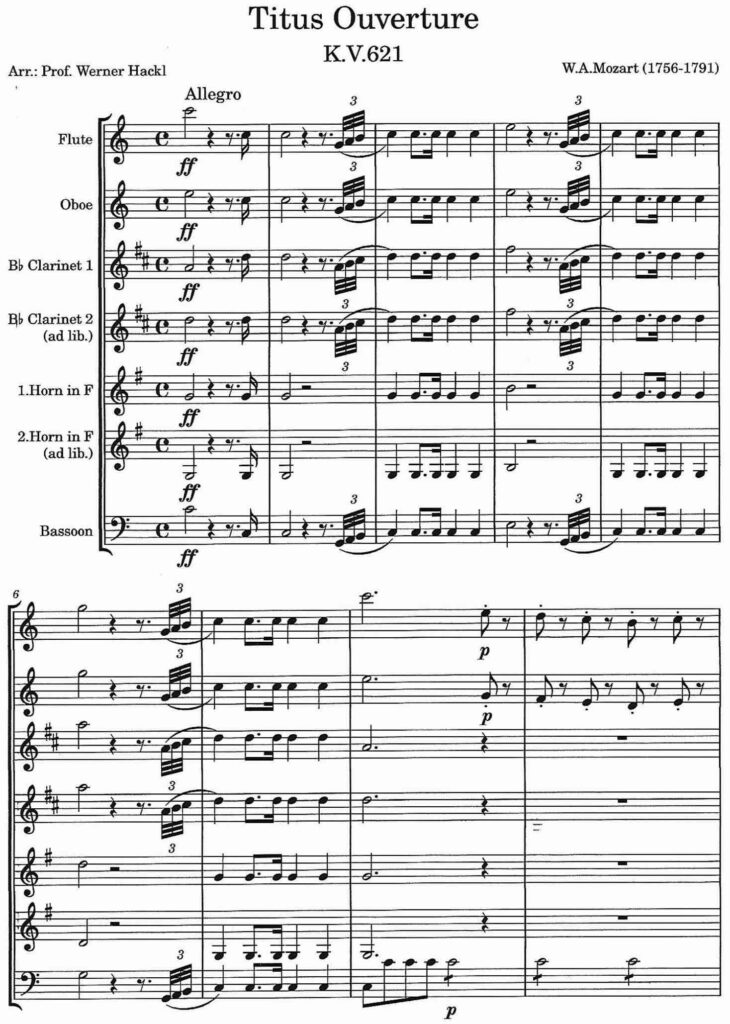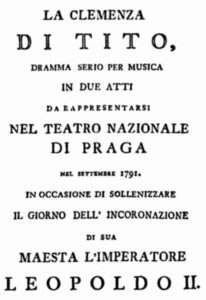Wolfgang Amadeus Mozart (1756-1791) Titus Ouverture, KV 621 for Woodwind-Quintet


Mozarts Titus Overture, im Original La clemenza di Tito (deutsch: Die Milde des Titus), ist das Vorspiel zu einer Opera seria, die am 6. September 1791 in Prag aus Anlass der Krönung Kaiser Leopolds II. zum König von Böhmen unter der Leitung von Mozart seine Uraufführung fand. Die böhmischen Stände vereinbarten im Vorfeld, dass die Krönungsoper von einem berühmten Meister („da un cellebre Maestro“) komponiert werden sollte. Nachdem Antonio Salieri wegen Arbeitsüberlastung das Angebot ausgeschlagen hatte, erhielt Mozart den Auftrag. Die Komposition des Tito schuf Mozart nahezu zeitgleich mit seiner Zauberflöte. Die Musik der Ouvertüre hat keinen thematischen Zusammenhang mit der eigentlichen Oper. Sie wurde gelegentlich als dramatisches Streitgespräch nach den Prinzipien Christoph Willibald Glucks aufgefasst und entspricht im Wesentlichen einer groß angelegten Sonatenform. Im Original spielen je zwei Flöten, Oboen, Klarinetten, Fagotte, Hörner, Trompeten sowie Pauken und Streicher. La clemenza di Tito entwickelte sich zu Mozarts erfolgreichster Oper hinter dem Don Giovanni und der Zauberflöte und blieb dies bis ins 19. Jahrhundert. Um das klassische Repertoire eines Bläserquintetts zu erweitern, hat sich Prof. Hackl dieser Bearbeitung unterzogen.

Mozart’s Titus Overture, originally La clemenza di Tito (Engl.: The mildness of Titus), is the prelude to an opera seria that was performed on September 6, 1791 in Prague on the occasion of the coronation of Emperor Leopold II as King of Bohemia and was premiered under the baton of Mozart. The Bohemian estates agreed in advance that the coronation opera should be composed by a famous master (“da un cellebre Maestro”). After Antonio Salieri turned down the offer due to overwork, Mozart received the commission. Mozart created the composition of Tito almost at the same time as his Magic Flute. The music of the overture has no thematic connection with the actual opera. It was occasionally interpreted as a dramatic argument based on the principles of Christoph Willibald Gluck and essentially corresponds to a large-scale sonata form. In the original, two flutes, oboes, clarinets, bassoons, horns, trumpets, timpani and strings play. La clemenza di Tito became Mozart’s most successful opera after Don Giovanni and The Magic Flute and remained so into the 19th century. In order to expand the classical repertoire of a wind quintet, Prof. Hackl undertook this arrangement.
| sound sample / Tonbeispiel | score/parts PDF download: € 19,- | add to cart / in den Warenkorb |
